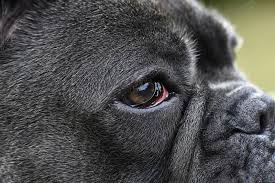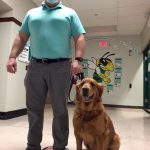Cherry Eye In Dogs
December 9, 2020

Spotting a red bump in the corner of a pet’s eye is a concerning but not uncommon experience for many dog owners. Colloquially called “cherry eye,” this bump may be a prolapsed gland of the nictitans, also known as the third eyelid.
Dr. Sean Collins, a clinical assistant professor at the Texas A&M College of Veterinary Medicine & Biomedical Sciences, says that ophthalmologists don’t entirely understand why the gland of the nictating membrane sometimes protrudes from its original position but it is believed to be a result of a weakness in the connective tissue responsible for holding the gland in the correct position.
“This condition can happen to any breed of dog but is seen most commonly in certain breeds, including the American cocker spaniel, English bulldog, Lhasa apso, and the Pekingese,” Collins said.
Pet owners who spot a red swollen mass in the inner corner of their pet’s eye, large or small, should bring it to their veterinarian’s attention promptly. In addition to causing irritation to the dog, this condition can have lasting consequences when left untreated.
“Without correction, chronic prolapse can lead to conjunctivitis (pink eye) and ocular discharge (liquid coming from the eye),” Collins said. “It has also been shown that with correction, dogs are less likely to develop low tear production later in life.”
Low tear production can result in multiple problems if left untreated. In addition to pain and decreased vision, corneal ulceration may also develop, which can become infected and result in a ruptured eye. This condition responds well to tear stimulant therapy in most cases, but lifelong medication is usually required. Your veterinarian will be able to confirm whether your pet has cherry eye and can develop a treatment plan that works best to resolve cherry eye and reduce the potential for ocular issues as your dog ages.
“Initial therapy may consist of topical anti-inflammatory therapy if local inflammation may be contributing to prolapse of the gland,” he said. “If a short course of medical therapy does not work or re-prolapse develops, surgical repositioning is indicated. There are numerous surgical techniques to reposition the gland with overall high success rates.”
If surgical treatment is required, Collins stresses that this treatment will benefit your pet in both the short- and long-term.
“Surgical repositioning is very important if initial medical therapy fails, as the gland is responsible for about 30-50% of the aqueous tear production in the dog,” he said. “We commonly see low tear production in the same breeds that develop a prolapsed gland of the nictitans. It has been shown that dogs with surgical repositioning of the gland have a lower chance of developing low tear production later on in life compared to those where the gland has been excised or remains chronically prolapsed.”
Unfortunately, there are no known preventative measures to protect against cherry eye in dogs, Collins says. This condition can develop in both eyes, usually before the age of 2. The best way pet owners can protect their furry friend is to remain vigilant in monitoring their pet’s health and to bring concerns to their veterinarian promptly in case an issue does arise.


 When Luke Hengen’s diabetes worsened in his early twenties, it stripped him of the outdoor activities where the country kid felt at home. Countless wilderness adventures and years of hard-fought football games took a toll on his body, to the point where he could no longer sense when his blood sugar was too high or […]
When Luke Hengen’s diabetes worsened in his early twenties, it stripped him of the outdoor activities where the country kid felt at home. Countless wilderness adventures and years of hard-fought football games took a toll on his body, to the point where he could no longer sense when his blood sugar was too high or […] When middle school students return to class on Jan. 11, they’ll find a new face at the door: Daisy. Daisy is a therapy dog and the personal pet of Rob Kreger, principal of the Rock L. Butler Middle School. The five-year-old golden retriever is not a school pet or mascot, but rather a working dog […]
When middle school students return to class on Jan. 11, they’ll find a new face at the door: Daisy. Daisy is a therapy dog and the personal pet of Rob Kreger, principal of the Rock L. Butler Middle School. The five-year-old golden retriever is not a school pet or mascot, but rather a working dog […] Last March, Caroline Benzel, a third-year medical student, began to notice the stress and discomfort her nurse friends were feeling from the pressures of the ongoing Covid-19 pandemic. “[Personal protective equipment] can be really rough on the skin,” Benzel, 31, tells PEOPLE. Benzel and her 3-year-old Rottweiler, Loki (who’s also a therapy dog) hatched a […]
Last March, Caroline Benzel, a third-year medical student, began to notice the stress and discomfort her nurse friends were feeling from the pressures of the ongoing Covid-19 pandemic. “[Personal protective equipment] can be really rough on the skin,” Benzel, 31, tells PEOPLE. Benzel and her 3-year-old Rottweiler, Loki (who’s also a therapy dog) hatched a […] When Stanley the miniature fox terrier’s owner passed away, the little dog started a ‘paw-some’ new role – bringing puppy love to some of the Gold Coast’s oldest residents. After Carinity Cedarbrook Diversional Therapist Julianne Staff adopted Stanley, he began visiting the aged care community at Mudgeeraba as a therapy dog. Therapy dogs help to […]
When Stanley the miniature fox terrier’s owner passed away, the little dog started a ‘paw-some’ new role – bringing puppy love to some of the Gold Coast’s oldest residents. After Carinity Cedarbrook Diversional Therapist Julianne Staff adopted Stanley, he began visiting the aged care community at Mudgeeraba as a therapy dog. Therapy dogs help to […] A nonprofit is providing an unusual form of therapy for those on the front lines of the coronavirus pandemic – puppy cams! “You spend five minutes with a puppy and try not to smile,” said registered nurse Robin Lingg Lagrone. Lingg Lagrone says watching little furballs wag their tails and prance on their paws helps […]
A nonprofit is providing an unusual form of therapy for those on the front lines of the coronavirus pandemic – puppy cams! “You spend five minutes with a puppy and try not to smile,” said registered nurse Robin Lingg Lagrone. Lingg Lagrone says watching little furballs wag their tails and prance on their paws helps […] When Moore County’s school doors were abruptly closed earlier in 2020, two- and four-legged volunteers from the Moore County Citizens’ Pet Responsibility Committee (PRC) were in their 12th year of presenting a six-session Pet Responsibility Education Program for fourth-graders. The PRC quickly shifted gears and placed its program materials online as part of a home […]
When Moore County’s school doors were abruptly closed earlier in 2020, two- and four-legged volunteers from the Moore County Citizens’ Pet Responsibility Committee (PRC) were in their 12th year of presenting a six-session Pet Responsibility Education Program for fourth-graders. The PRC quickly shifted gears and placed its program materials online as part of a home […]